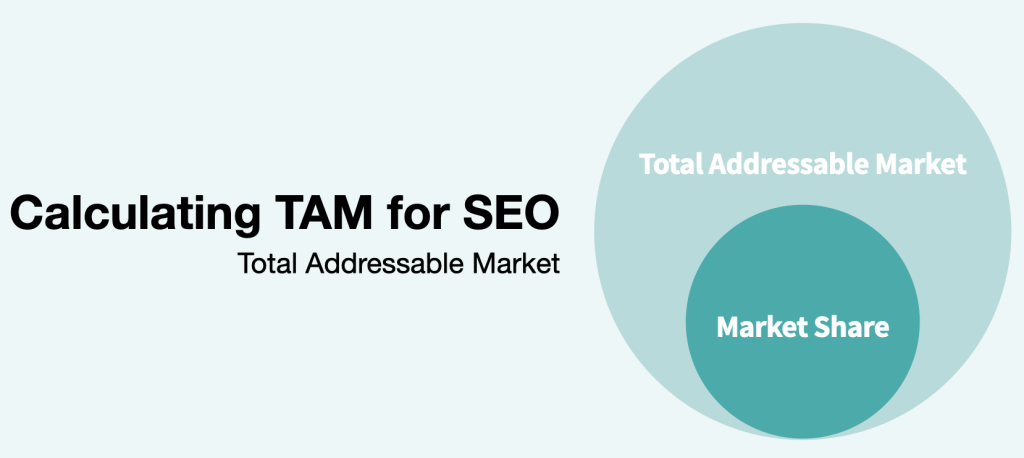A couple of months ago, I was one of the participants in the SEO MBA program by Tom Critchlow. It was a 5-week long workshop series going through all kinds of subjects that matter in dealing with the executive level regarding SEO. We touched briefly on the subject of TAM (Total Addressable Market) along the way ts) as well.
In itself, I’d say this is a topic that isn’t often talked about in the context of SEO, so through this blog post, I want to spend more time talking about it as through years of working in/with startups, it keeps coming back. An often discussed question in board rooms around company potential remains; “What do you think the TAM is for this market, and how does that influence the potential long-term valuation?”
Why is knowing your Total Addressable Market useful:
- Find out the maximum reach for the product/service that you’re developing?
- What is the maximum market share for you to gain in this TAM?
- Provides you an insight into the size and adjacent industries that are relevant for you.
How to leverage TAM for SEO & PPC
In the context of industries and segments, TAM is a powerful tool for SEO & PPC because it will help prioritization for content creation. Companies with many smaller segments and an average SEO team will have to prioritize what they can work on as they often don’t have the resources to go broader. Knowing what a search-focused TAM looks like can help you identify what to focus on first.
Note: This is not the only exercise they should be doing to prioritize, as the competitive nature of the industry should also play a role in this.
Identifying segments
Most categories within your business can be easily defined. For example, RVshare is, guess what: RV rentals. Which wasn’t hard to figure out, and you can likely do this for your business as well. But where Total Addressable Markets come in is expanding this. Let’s use an example:
RV Rental > Camping > Outdoor > Vacation > Travel
See what just happened there. Within seconds we went from a subset of a subset to the major category of Travel. It’s a high-level example, but it also applies in a more granular way:
Red BMW X5 for Sale > BMW X5 for Sale > BMW for Sale > Car Sales > Vehicle Sales
On this one, the last piece is a stretch, if you’re a car sales company, it’s often unlikely that you sell tons of different vehicles as well, but if you’re specifically looking for a red X5, you’re likely in one of the upper segments as well.
Calculating Click Share & Share of Voice
In the context of PPC, most folks will be familiar with the click share for ad groups or campaigns as it’s the percentage of clicks you’re receiving as part of a keyword subset. It’s beneficial in the context of TAM and search channels as it could indicate what the maximum click share (read; market share) could be for clicks. Because the chances are high that you’re not able to capture 100% of clicks on your properties (even if you claim all other positions in the SERP).
Want to know more about this? I’ve previously blogged about:
- Using Keyword Rankings In SEO
- Calculating Click-Through Rates for SEO, based on Google Search Console Data (in R)
Calculating TAM for SEO
All Keywords within your segment * Search Volume = Total Search Volume / TAM
Makes sense? Calculating this metric in itself is not that hard, as it’s just a quick math equation. However, getting the data for a full segment or industry is much more complicated, so how do you get this data. But there are many ways to do this yourself simply. Only if you’re in an industry with tens of thousands to millions of keyword combinations (home sales, travel, etc.), you likely need more resourcing to support this.
- Export all your keyword data from Google Search Console or Google Ads/Microsoft Advertising.
- Calculate the yearly total search volume for those keywords.
- Find any other related keywords in your industry:
- Leverage related keyword tools.
- SEMrush, Ahrefs can provide you with tons of keyword insights for your competitors.
- Gather all this data back together and calculate the total market size & your share (your clicks).
At scale, for bigger industries, the process is a bit more complex as you have to digest more data to get to an accurate answer to your sizing problem. In addition, you’ll run into more data or keywords that might look relevant but aren’t, which you’d have to shift through. So, what’s the size of your Total Addressable Market (TAM)?
